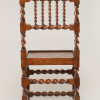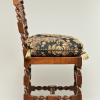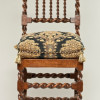- Seating
- 17th Century Double-Twist Turned Chair
17th Century Double-Twist Turned Chair
Member Gallery
Address
Contact
A late 17th century double-twist turned chair designed after two identical chairs that are found at the Philadelphia Museum of Art and the Winterthur Museum. These two chairs may have been built in the Philadelphia area. Furniture historian and influential style setter Wallace Nutting, in his Furniture Treasury, featured a photograph of the Philadelphia Museum of Art chair. The caption stated: "A number of these chairs found in the same vicinity of this type, lead to the belief that they are native." According to furniture historian Benno Forman, "Winterthur's chair is one of the rarest survivals of the American framed-chair maker's art and was undoubtedly equally rare in its time because of the large amount of labor required to make them."
The double-twist components of these chairs historically had many names; French turned or Dutch turning were common, and they were also known as barley twists referring to a popular candy at the time. This characteristic was relatively common and often appeared in chairs produced in Restoration England during the reign of Charles II (1660-85). Turning a double twist on a conventional lathe is impossible. Fortunately, in 17th century England, spiral-turning lathes, where the workpiece was moved against a stationary cutter, (similar to today's Rose Engine) were available, and made the production of double-twist turnings possible. Unfortunately, a spiral turning lathe or Rose Engine were not available, so the double-twists in back, leg, and base stretchers of Steve's chair were carved by hand.
FINISH: To get the dark-walnut appearance, the cherry wood was first sealed with Charles Neil's Pre-Color Conditioner to prevent blotching and then stained with a 50/50 mixture of Constantine's Walnut and Mahogany Non Grain-Raising stains thinned 50 percent. Two coats of 1.5# cut of super blond shellac were applied and finished with Sam Maloof's Oil/Wax finish.
UPHOLSTERY: Michael Mascelli
PHOTOGRAPHS: Dirk Bakker
REFERENCES: Nutting, Wallace. Furniture Treasury, Volume 1 & 2, 1988. Plate #2087.
Forman, Benno M. American Seating Furniture 1630-1730, 1928. Cat. #48.
PROVENANCE: Lash, Steven M. "Double-Twist Turned Chair." American Period Furniture, December 2014: Volume 14, pp 48-55.
Mascelli, Michael. Techniques and Materials: Getting Upholstery Right." American Period Furniture, December, 2013: Volume 13, pp 94-99.




